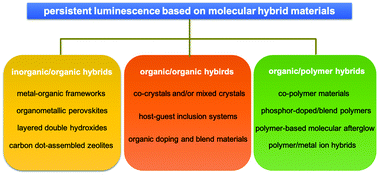Recent advances in persistent luminescence based on molecular hybrid materials†
Abstract
Molecular persistently luminescent materials have received recent attention due to their promising applications in optical displays, biological imaging, chemical sensing, and security systems. In this review, we systematically summarize recent advances in establishing persistently luminescent materials—specifically focusing on materials composed of molecular hybrids for the first time. We describe the main strategies for synthesizing these hybrid materials, namely: (i) inorganics/organics, (ii) organics/organics, and (iii) organics/polymer systems and demonstrate how molecular hybrids provide synergistic effects, while improving luminescence lifetimes and efficiencies. These hybrid materials promote new methods for tuning key physical properties such as singlet–triplet excited state energies by controlling the chemical interactions and molecular orientations in the solid state. We review new advances in these materials from the perspective of examining experimental and theoretical approaches to room-temperature phosphorescence and thermally-activated delayed fluorescence. Finally, this review concludes by summarizing the current challenges and future opportunities for these hybrid materials.



 Please wait while we load your content...
Please wait while we load your content...